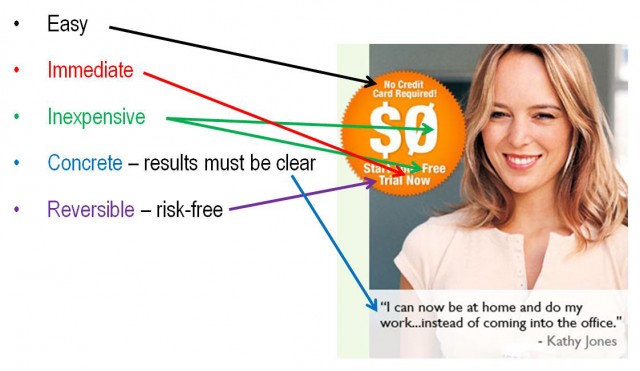 In his book Enchantment , Guy Kawasaki encourages entrepreneurs to immerse their audience in their “cause”, in order to enchant them. One of the immersion techniques Guy promotes is to offer a hands-on trial, in which the prospective customer can touch, feel and experience your product before purchasing it.
In his book Enchantment , Guy Kawasaki encourages entrepreneurs to immerse their audience in their “cause”, in order to enchant them. One of the immersion techniques Guy promotes is to offer a hands-on trial, in which the prospective customer can touch, feel and experience your product before purchasing it.
If you care to learn more about the enchantment process, you may want to watch my interview with Guy HERE, in which he provides a number of enchanting tips and tricks.
If you haven't already subscribed yet,
subscribe now for free weekly Infochachkie articles!
Characteristics Of An Effective Direct Response Trial Offer
In Chapter 5 of Enchantment, Guy identifies the following characteristics of an effective trial offer.
- Easy
- Immediate
- Inexpensive
- Concrete
- Reversible
I tested the efficacy of Guy’s criteria by reviewing a cross section of online, direct response trial offers. In most instances, the majority of the above characteristics were present. In one particular GoToMyPC trial offer, Guy’s suggestions are coupled with a number of additional persuasion techniques. I illustrate the use of these tactics of influence below.
Guy’s Recommendations In Action
In addition to the five factors described by Kawasaki to encourage consumers to accept trials, this particular ad contains a number of additional persuasion techniques, including:
Call To Action – Effective direct response ads are often more explicit in their call to action than the example show here. For instance, terms like “Click to start your free trial,” or “Click here,” are not evident. This muted call to action might reflect that the ad was intended to also be used as a component of a landing page that would display a more visible call to action. It might also be that within the forums in which these ads were shown, an aggressive, in-your-face approach would have been inappropriate.
The sunburst design around the circle is no accident. Our testing consistently found that such “bursts” (as we called them) were always more effective than a simple circle. Similarly, the orange color show here is the same color we used years ago, as we found it to be more efficacious than alternatives.
A/B Testing – We learned that orange was the ideal color and that a burst was better than a circle via rigorous A/B testing. This methodology involves alternating ads which are identical, with exception of one key variable. This approach facilitates isolating the relative impact of individual elements of an ad campaign.
Although I have no first-hand knowledge, I am pretty confident that Citrix found through rigorous testing that the zero with a line through it was more effective than a plain zero. A/B testing requires marketers to leave their egos and emotions at the door and allow quantifiable metrics to drive their decisions.
Common Name – As Cialdini, et al note in Yes! - 50 Scientifically Proven Ways To Be Persuasive, liking (and thus persuasiveness) is accentuated when the persuader has a name that is similar to the person being persuaded. In one study, 56% of the subjects were twice as likely to complete a survey sent by someone with a name similar to their own, versus 30% of the subjects in the control group.
The model’s name might actually be Kathy Jones or possibly a real “Kathy Jones” wrote the testimonial. However, given the generic nature of the name and the persuasive power of similar names, my presumption is that this name was strategically selected.
Smiles Work – Smiling invokes liking, which heightens persuasion, as long as the smile is deemed to be genuine. In Yes!, the authors describe a study in which restaurant customers were consistently “more satisfied” with the service provided by waitstaff who displayed genuine smiles, as compared to food servers who displayed disingenuous smiles.
Attractive Peer – People buy from people they like. People like people who are like them. As such, marketers seek images of peers derived from the target audience they are seeking to influence. In this case, the ad is clearly speaking to professional mothers who need the flexibility to work from home in order to tend to childrearing and other domestic responsibilities.
It is also a scientifically proven fact that attractive people are rated as more credible and likeable (and thus more persuasive), as compared to people with average and below-average appearances. In one study of Canadian federal elections, researchers noted that attractive politicians received two and a half times as many votes as their less attractive opponents.
In a review of the Pennsylvania judicial system, researchers determined that attractive defendants were twice as likely to avoid jail, as compared to their unattractive counterparts. Of those attractive defendants who were sent to jail, they consistently received shorter sentences than those given to less-attractive criminals. Cialdini summarizes this phenomenon by stating, “…good-looking people enjoy an enormous social advantage in our culture. They are better liked, more persuasive, more frequently helped and seen as possessing better personality traits and intellectual capabilities.” As such, it is no surprise that marketers have used pretty people to sell their products since the dawn of modern advertising. Direct response trials are no exception.
Gender Bias
To belie any fears that folks at Citrix are sexist, I have included below a nearly identical ad which utilizes a male model. Note that he also displays an authentic smile and has a common name. Everything else in the ad is identical, except the testimonial, which highlights reducing the user’s time spent at the office after hours and on weekends. The implication of the ads’ respective testimonials is that women are more prone to work from home in order to balance their family obligations, whereas men are more likely to work late and on weekends.
Peer testimonials are more impactful than recommendations from people who are dissimilar from the intended audience. Thus, a man in a tie delivers the “work late” message, while a professional woman of child rearing age communicates the “work balance” referral.
On a side note, when I was marketing GoToMyPC, our A/B testing consistently found a gender bias with regard to both male and female consumers. Ads which displayed a photo of a woman nearly always out-performed identical ads in which we substituted a photo of a man. It would be interesting to know if this is the case with these two direct response trial ads.
High Volume Means Sumpin Is Workin’
Unlike traditional advertising campaigns, which are difficult to track, direct response trial ads follow the Pour And Stir methodology. When such ads work, advertisers are comfortable placing significant money into promoting them because they can directly track the point at which they reach diminishing returns. As long as the cost per customer is less than the average customer’s lifetime value, each incremental customer increases the value of the company.
Thus, whenever you notice a high frequency of direct response ads, online or otherwise, you can be sure that such ads are effective. Whether it is a Snuggie, the ShamWow or GoToMyPC, the techniques implemented in such high-rotation ads are persuading their targeted demographics to take the desired actions.
As such, entrepreneurs can learn a tremendous amount about effective online persuasion by studying the characteristics of high-volume, direct response ads. Especially ads created marketing masters, such as Citrix Online.







